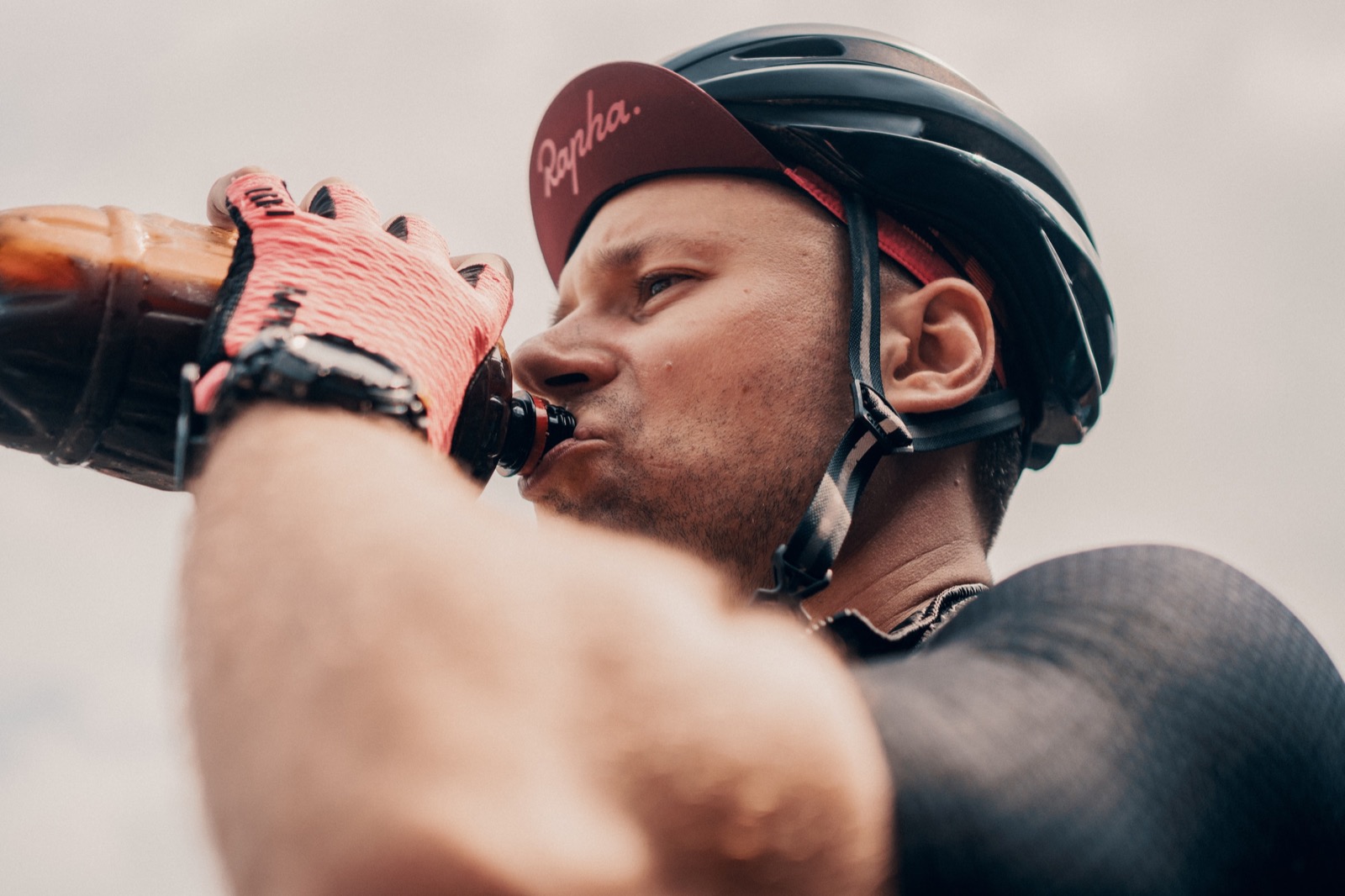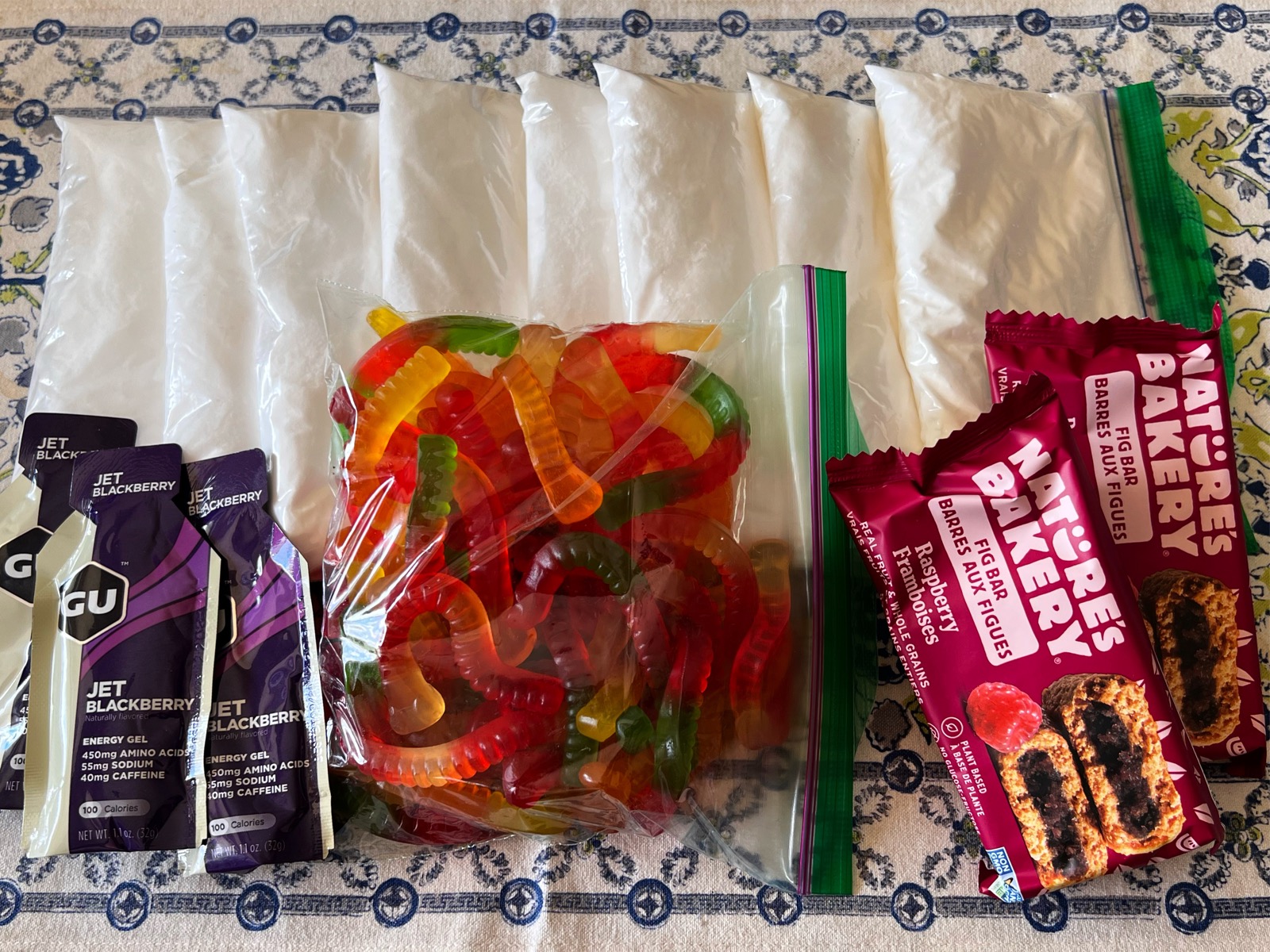Custom cycling nutrition for dirt cheap

Nutrition was the most challenging puzzle to solve when I started riding long distances. On even a moderately paced ride, it’s easy to burn 600 calories an hour. For a ride of two or three hours, it’s possible to get by with inadequate fueling. But once I started doing 200km+ rides, I’d consistently reach a point where eating any solid foods felt like an impossible task, let alone consuming enough calories to perform at my best.
During one of my first randonneuring brevets, I was chatting about this problem to a seasoned veteran who gave me a sly grin as he pulled a bag of white powder out of his jersey pocket. “Have you ever heard of maltodextrin? It will change your life.” Once my child of the 80s Just Say No alarm bells died down, I was intrigued. Over the next several months, I went down a rabbit hole of sports nutrition that involved trying expensive endurance sport-specific nutrition products and then scouring internet message boards and research papers to recreate them at home. It’s a fun way to spend a Canadian winter, but if you want to shortcut all that, here’s everything you need to know.
The science
I am not a sports nutritionist, so take all this with a grain of sodium citrate (that joke will be funnier by the end of this post).
What should you be eating on rides?
For beginners, here are some basics: Carbohydrates are the macronutrient most easily converted to energy that we can use. Fat can also be used as fuel, but it takes more effort and time for your body to process, which makes it less than ideal during exercise. Protein can not be used as an energy source, although it is valuable in repairing muscle damage after your workout. During the ride, you want all of your calories to be carbohydrates. But not just any carbohydrates. You want the easiest to process, most efficient carb: sugar.
Wait. Sugar? “The new tobacco” is the key to sports nutrition? Yes! It took me a while to wrap my head around it, but everything that makes sugar so harmful in day-to-day settings makes it a perfect fuel for sports. In fact, the only significant difference between candy and sports-specific nutrition products is the branding and maybe some electrolytes, which you pay a substantial markup for. Gatorade is sugar water, Cliff Shots are gummy worms in cube form, and Jelly Belly Sports Beans are (wait for it…) jelly beans.
There are some finer points beyond “actually sugar is good,” but the only other important thing to understand here is that your body processes glucose and fructose differently. After digestion in the gut, glucose is transported through the bloodstream directly to your muscles for use as energy. Fructose first has to pass through the liver, where it’s broken down to glucose and lactate, which can then be used as fuel.
How much should you be eating on rides?
For several decades, the accepted wisdom was that your gut can digest 60g of carbs an hour (which translates to 240 calories) and no more. Since glucose is more efficiently processed than fructose, many sports drinks use glucose sugars exclusively. In the early 2000s, researchers started demonstrating that different receptors in the gut were used to process glucose and fructose. This meant that while you were still limited to 60g of glucose an hour, you could also process a certain amount of fructose, increasing the total amount of available calories. The new recommendation became 90g of carbs an hour, with a 2:1 ratio of glucose to fructose.
More recently, scientists like Tim Podlogar have been testing both the assumptions around total quantity and the ratio of glucose to fructose. As of 2022, almost all pro cycling teams now use 120g of carbs per hour, and there’s evidence that a 1:0.8 ratio of glucose to fructose may be optimal.
From a big-picture perspective, the main takeaway is that assuming your stomach can handle it, you probably can’t over-fuel on a ride, but you can definitely under-fuel.
My standard drink mix
Ok, so with that all out of the way, let’s make some drinks! This recipe makes one hour’s worth of carbs, so use a bottle size that matches your hourly fluid intake.
| Ingredient | Quantity | Calories | Cost/Serving |
|---|---|---|---|
| Maltodextrin | 30g | 120 | $0.40 |
| Table sugar | 60g | 240 | $0.07 |
| Sodium Citrate | 1 tsp | N/A | $0.04 |
| True Citrus | 1 packet | N/A | $0.10 |
| Total | 1 bottle | 360 | $0.61 CAD |
For longer rides over a couple of hours, I usually ride with one bottle of water and one bottle with double this recipe. Drinking sugar water for 10+ hours is not great for your dental health, so chasing a swig of sports drink with a rinse of pure water helps remove residual sugar from your teeth and gums. By doubling the concentration, I still consume two hours’ worth of carbs and water together.
Although I mentioned above that many riders are now doing more than 90g of carbs an hour, I keep my drink mix at 90g and supplement with some solid foods. I’ve tried doing all-liquid rides up to 300km, but after six or seven hours of drinking the same thing repeatedly, I crave some variety.
Ingredient breakdown
Chances are good that the only ingredient in your kitchen cupboard right now is the table sugar. But the others are readily available on Amazon or your local bulk foods store. Here’s why we’re using these and the benefit they provide.
Maltodextrin
This is the key to the whole mix. Maltodextrin is a long-chain glucose that tastes less sweet than fructose and is easier to digest. If you are just starting out with making your own sports drink and want 80% of the benefits for 20% of the effort, try adding 60g of maltodextrin to a bottle of water and skipping everything else here. Homebrew supply stores are an unconventional but reliable source for maltodextrin since it’s a common ingredient in making beer. I usually get mine off Amazon in a 5kg bag that lasts 160 bottles.
Table sugar
Just your regular white sugar from the grocery store. Table sugar has a 1:1 mix of glucose and fructose. I used to use pure fructose instead of table sugar, but at some point during Covid, fructose became hard to find in Canada. So I switched to table sugar and haven’t noticed a difference. I suspect that people with sensitive stomachs may have trouble with higher fructose levels, so if that’s you, try dialing down the sugar and see if that helps. If you do use pure fructose instead of table sure, increase the amount of maltodextrin you use to keep the ratios correct since you will lose table sugar’s glucose content.
Sodium Citrate
In addition to carb intake, electrolyte replacement is the other primary function of ride nutrition. The amount of sodium you need per hour is highly variable depending on how much you sweat, how salty your sweat is, your physical conditioning, the weather, etc., so you will definitely want to experiment with the amount you use. I find that when I go over 1000mg of sodium a bottle (1 teaspoon of sodium citrate), I can start to have some minor stomach discomfort. On sweltering days I’ll also supplement with Salt Stick electrolyte capsules, which don’t cause any issues even when taken alongside a full serving of my sports drink.
You could use table salt instead of sodium citrate, but sodium citrate is absorbed more easily by your gut, so you can use more of it without adding GI stress. For more info about sodium replacement, Alex Harrison has a good video that goes much deeper.
True Citrus packet
This is just for flavoring; you could substitute it for many other options. True Citrus comes in various flavors, which are all fine except for grapefruit. That one’s super gross for some reason.
The finished product
Here’s what my setup looked like for a 600km ride earlier this year.

Each Ziploc bag contains a double portion of my base recipe, so that’s 1440g of carbs or 5,760 calories. Of course, I burned 14,416 calories on that 37 hour ride, which is why there are also gels, bars, and my morale boosting secret weapon, gummy worms. If I remember correctly, I pulled a couple of bars out of this photo because I was a little embarrassed at how much food I was bringing.
Combined with a few quick stops for real food, this worked really well. I never felt hungry, I never felt too full, and I never reached a point where I couldn’t eat. Since that was the issue plaguing the beginning of my randonneuring journey, I count that as a win.
Variations
There are plenty of opportunities to experiment with this recipe. Here are a couple of things I’ve tried.
Protein
I mentioned earlier that protein has no use as a fuel source. But if you are riding ultra distances, you will need more macronutrients than just carbs for your body to function correctly. Drinks designed specifically for ultra-endurance sports, such as Hammer Nutrition’s Perpetuem, include 4g of protein per serving to help your muscles recover during the event. I’ve tried adding unflavored whey protein to my mix but didn’t love the texture of my drinks. You might have better luck with a different brand than I used.
BCAAs
Branch Chain Amino Acids contribute to muscle repair and delay fatigue. Occasionally I’ll add some to my mix if I remember, but if there are benefits, they are pretty subtle.
Larger servings and different ratios
While many people are moving to 120g of carbs an hour, I keep my drink mix at 90g and supplement it with solid food. I think it could be interesting to move up to 120g for riding through the night or other times when my body doesn’t want to take in solid food. I’ve also kept my mix at a 2:1 ratio instead of the newer 1:0.8 glucose to fructose recommendation because I thought it tasted too sweet when I tried a more balanced mix.
If you want a 120g bottle at a 1:0.8 ratio, try 34g of maltodextrin and 88g of table sugar.
So should you be making your own sports drinks?
There are two main advantages to making your own sports drink. The first is cost. My recipe works out to $0.61 CAD per serving. SiS Beta Fuel is about $4.15 CAD per serving, Maurten is $4.86 CAD, Perpetuem is $4.92 CAD. Over a season, making your own drink mix can add up to hundreds or even thousands of dollars in savings.
Second, and perhaps even more important, is that you can customize everything to fit your needs. Want to perfectly optimize your carb intake? Are you a super salty sweater? Do you have particular flavor preferences? The pros all have customized nutrition, and there’s no reason you shouldn’t as well.
